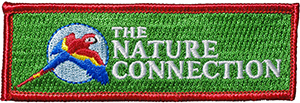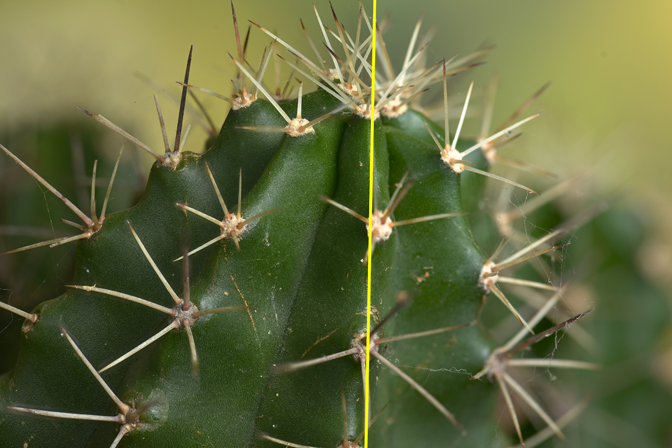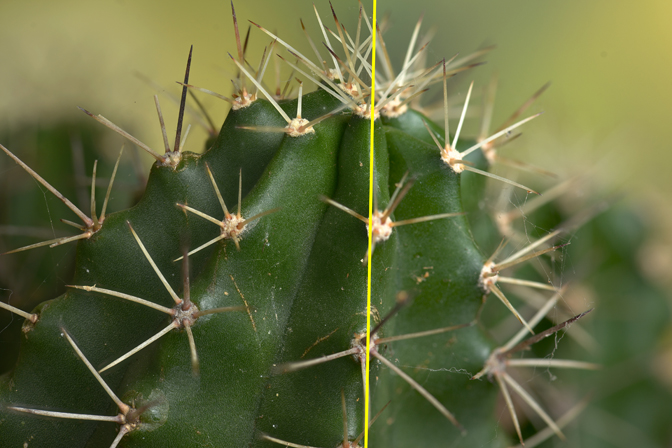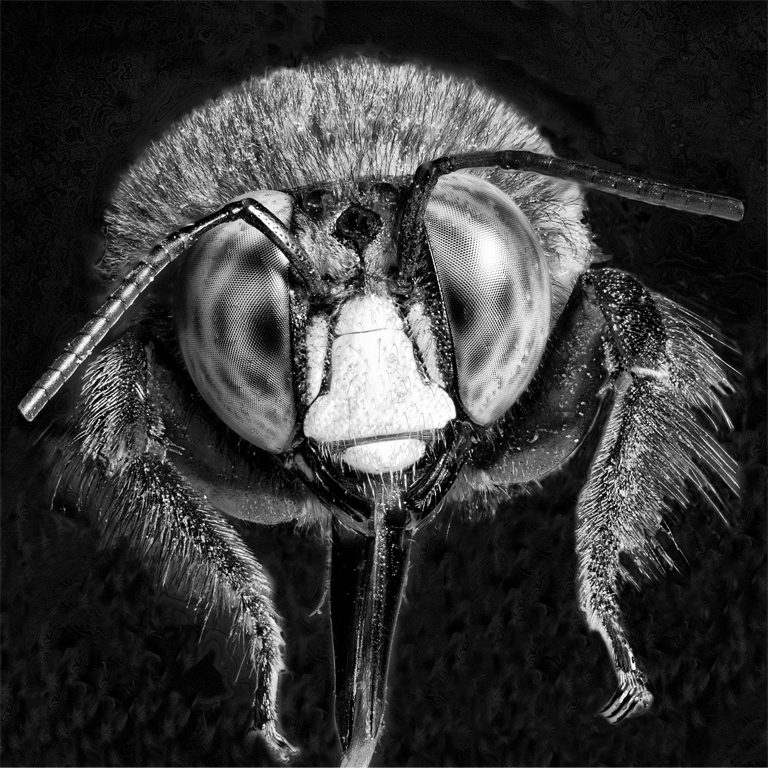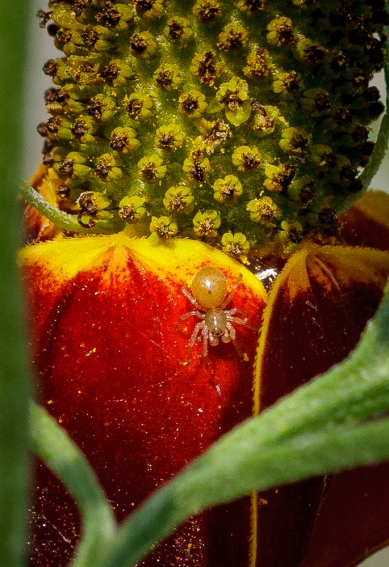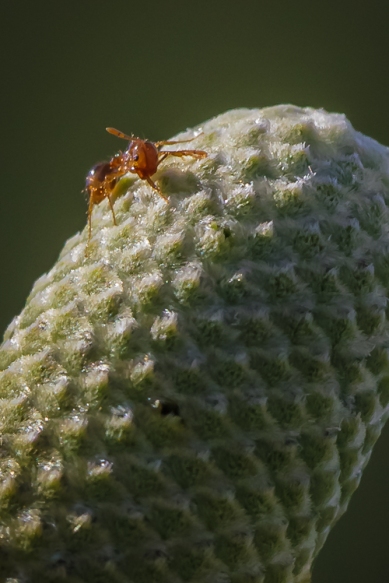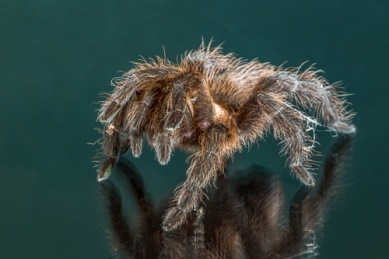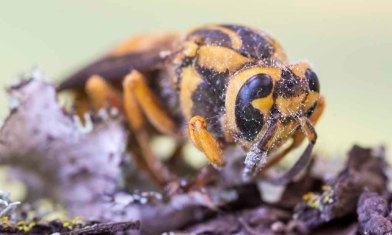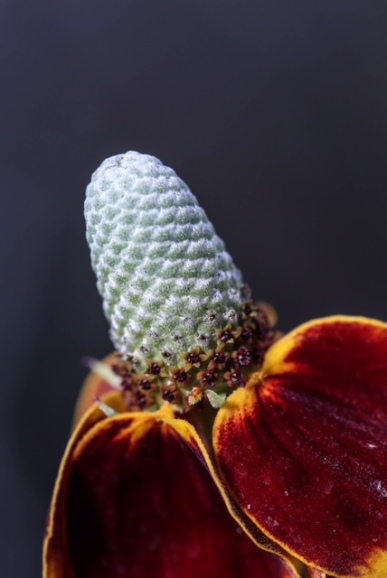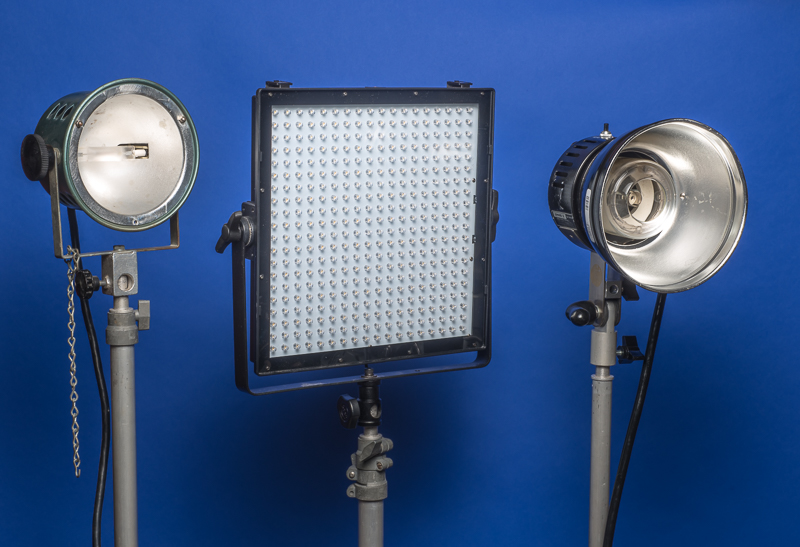
Illustrated from left, above: Quartz hot light, LED panel, Studio flash.
Many folks spend most of their time practicing their photographic craft outdoors. They consider themselves “Natural Light” or “Available Light” photographers. And many do an excellent job with their work. However, when it comes to moving indoors, photographic lighting becomes significantly different and many photographers are somewhat naïve, timid or downright afraid of indoor lighting and the tools required. Sometimes this fear is due to equipment cost, but I believe more often it’s the lack of understanding of the available tools. There are many, many light units available, but only some are designed specifically for photography. Let’s spend a few minutes building a better understanding the tools of indoor lighting for photography and the features and benefits of each.
Continuous Lighting or Flash
First, we basically have two different sources of artificial photographic lighting, continuous or flash. Each source of light has several styles of lighting units and each has its advantages and disadvantages. Let’s look at each.
Continuous Lighting
Continuous lighting, as the name implies, is a lighting source that is “on” all the time; it burns continuously. Two things to consider are the lighting source or type and the style of the fixture or the light unit itself. Continuous lighting basically is available in three different types of sources: Hot lights, Fluorescent and LEDs.
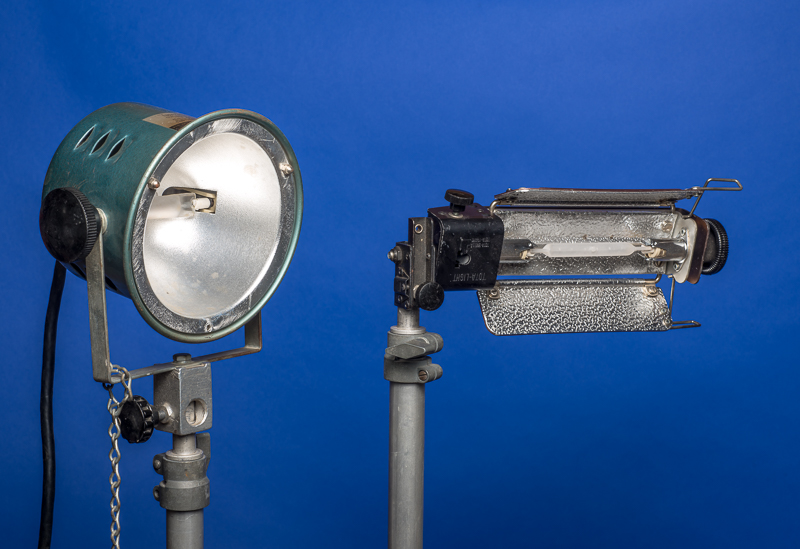
Quartz hot lights in parabolic can (left), and broad quartz soft light.
Hot lights use a heated and glowing filament as a source of light. Contained within a glass tube the filament is sometimes within a specialized gas that adds a special color characteristic to the light. These lights acquired their name because they become extremely hot as the filament burns. Somewhat inefficient, most of the energy used produces heat instead of light. Hot lights are most frequently tungsten white balance in the 3,200 – 3,800 degree Kelvin range. Hot lights come in many different sizes, fixture styles and price range, some quite inexpensive. A specialized type of hot light is the HMI lighting units. Originally HMIs were offered for the motion picture and video industry. These units are generally expensive and have specially constructed lamps and ballasts to provide flicker-free daylight white illumination around 6,000 degree Kelvin.
Fluorescent lighting for photography uses specialized fixtures, fluorescent tubes and ballasts to offer cool, flicker-free light. The color temperature is around 5,000 degrees Kelvin, a little warmer than daylight. Photographic fluorescent lighting is available in several fixture styles and can be somewhat expensive.
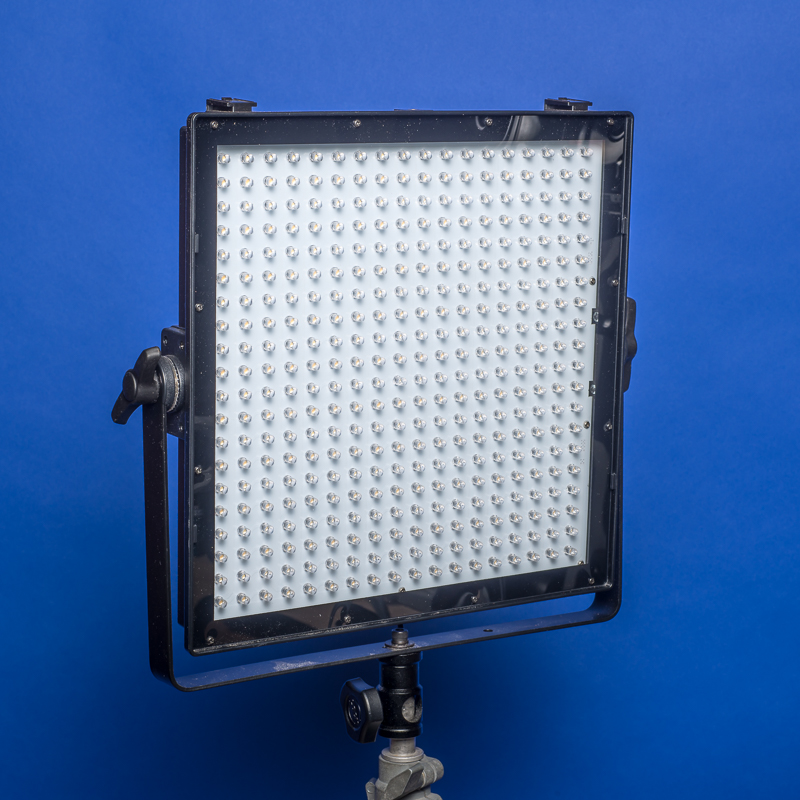
Flat LED panel is AC and battery powered, with variable output and color temperature.
LED lighting makes use of new technology light emitting diodes. These lights are now most convenient as they are actually cool to the touch and can be AC or battery powered. LED lighting may be daylight or tungsten color balance. LED lighting fixtures are available in many different shapes from rectangular panels to cylindrical styles and can be somewhat inexpensive.
Regardless of the light source or fixture type, a major advantage of continuous lighting is that it can be visualized from the camera and its effect adjusted easily. A disadvantage of some continuous lighting units is they burn at one intensity level. Therefore, to change the intensity at the subject, these fixtures need to be moved closer or more distant.
Electronic Flash
Electronic flash provides a very versatile source of light. It is a high-speed burst of light created by a high energy electronic pulse through a gas filled glass tube. Three major advantages to this type of illumination are that it closely matches daylight in color, it is cool to the touch and it is very fast, often around 1/1000 second or faster. Two types of electronic flash are common, studio strobes and miniature flashes (often called hot shoe flashes or SpeedlightsTM).
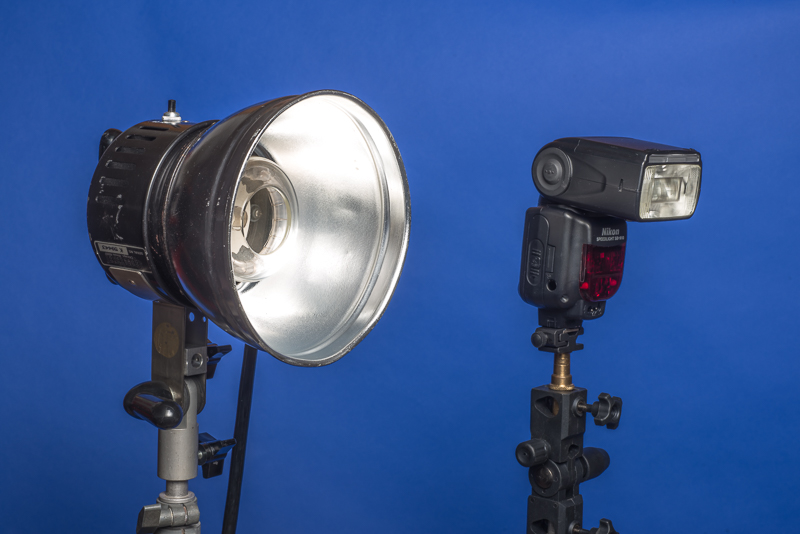
Studio flash head (left) and NIKON Speedlight.
Studio strobes are AC or battery powered units in several different fixture types and power levels. Two styles prevail, a self-contained monolight where all electronics are contained within the lighting unit and a style that has the lamp in a fixture separated by a cable from the electronics and transformer unit.
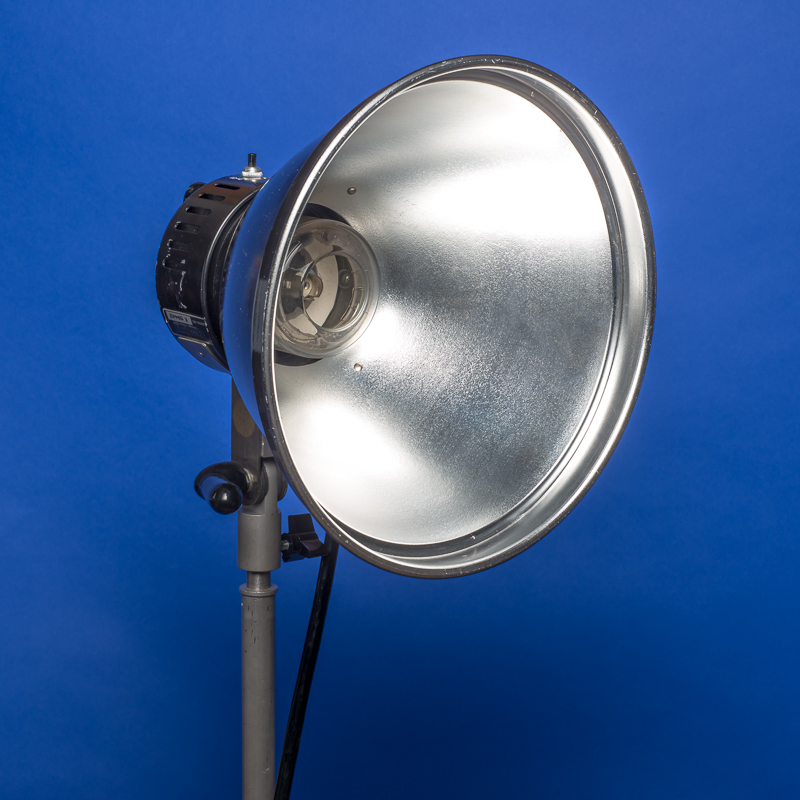
Larger parabolic dish flash head.
The studio flash is more frequently a stand-mounted unit. It may come with a variety of light modifiers and is frequently very powerful. In today’s digital photography, a single studio strobe may provide enough lighting power to illuminate half a basketball court. They are now available in variable power and with electronic TTL controls to be controlled by the camera exposure settings. Compared to other flash options, these units can seem quite bulky, heavy and expensive.

NIKON SB-910 Speedlight miniature flash. One of the most versatile flashes on the market today.
Miniature flashes on the other hand are small, lightweight and versatile units. They are available from many manufacturers, especially the major camera manufacturers. That is an important issue in that the electronics of the camera and flash are required to “talk” to each other. These flashes are available in several styles and power for on-camera and more efficiently, off camera operation. They may be relatively inexpensive.
A true advantage of the miniature or hot shoe flash is the versatility of the power output. Many units provide reasonable high power for indoor events, products and portrait work. A significant bonus of the miniature flash is the ability to turn the speed of the flash burst up to incredibly high speeds, at 1/50,000 second or faster, enabling the demonstration of high speed motion such as hummingbird wings or insects in flight. A table of these high flash speeds possible from Canon and Nikon follows:
FLASH DURATION
Power NIKON (Sec) Canon (Sec)
1/1 1/1,050 1/1,000
1/2 1/1,100 1/2,000
1/4 1/2,700 1/4,000
1/8 1/5,900 1/9,000
1/16 1/10,900 1/15,000
1/32 1/17,800 1/21,000
1/64 1/32,300 1/30,000
1/132 1/41,600 1/35,000
Light Modifiers
In order to use photographic lighting effectively it should be modified. Generally speaking, most light sources offer a small, point source and high contrast light. This in itself is not very appealing as an illuminant in a photograph. Like the outdoor bright sun, it needs to be modified.
The rule of thumb in effective light modification is to make the lighting source larger and closer relative to the subject. Like overcast skies, this procedure results in softer, more pleasing light. There are many ways to do this.
Lighting Fixtures
The lighting fixture is the first step. The fixture is the instrument that contains the lamp and often a modifier in the form of a reflector of several shapes, a diffuser or other styles of devices that modify the light path.
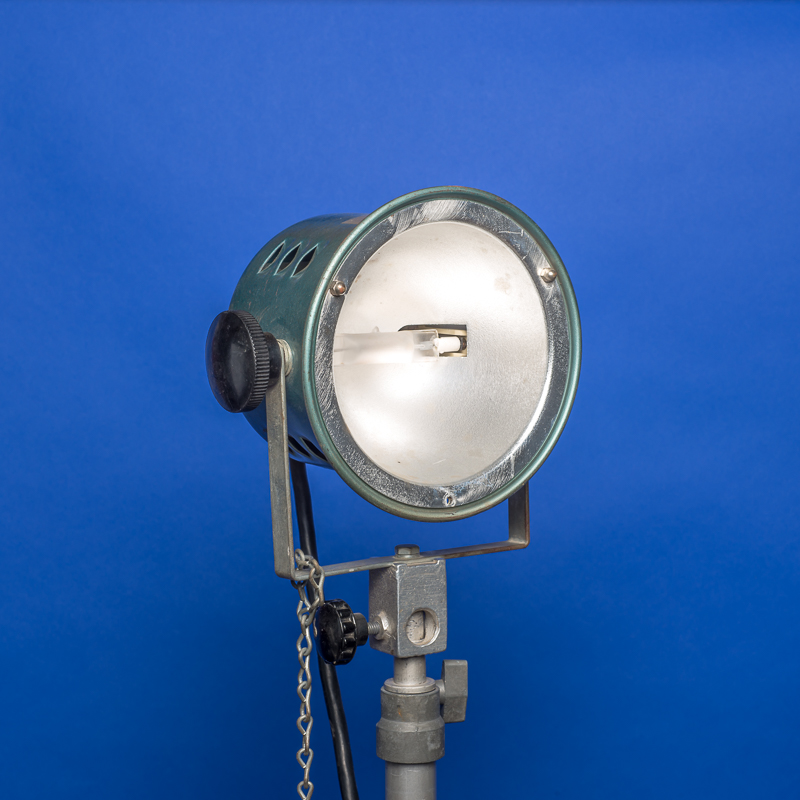
Parabolic fixture.
Fixtures are offered in a variety of styles. The PAR or fixture with a parabolic reflector is a most common type. The size and shape of the parabolic dish controls the width of the beam of light. Commonly available are wide-beam floods and narrow-beam spots or variable-beam PARs.

Fresnel fixture. Note lens in front of lamp.
Another similar fixture is a Fresnel. Similar to a PAR, the Fresnel has a lamp with a reflector behind it and a specialized, concentric curved, Fresnel lens in front of the lamp that forms and directs the beam. These may be as small as 250 watts or as large as 10,000 (10K) watts.
Modified soft light lamp houses may provide softer light from a “Hot light” source by designing an enclosure around the light source that bounces the light backward and from a large integral reflector surface. These are used frequently to light larger areas and products.
Another fixture used predominantly on the stage is the focusing spot or projector. Usually a powerful and highly concentrated beam of light, this style is used for providing highlight on a very small area. To maximize the versatility of any lighting fixture it should be used with an external modifier.
External Modifiers
The beauty of external modifiers is that they may be very inexpensive, quite portable and used with many different fixtures.
Reflectors are by definition a flat surface that can bounce (or reflect) the light from a fixture onto the subject or set. The may be made of many materials. Lightweight foam-style board and frame-supported fabric are most common. Colors may range from white, silver, gold, and gold/silver zebra striped, each with its own set of reflective and color characteristics. They are available in circular spring-loaded styles a few inches in diameter to rigid boards of several square feet.
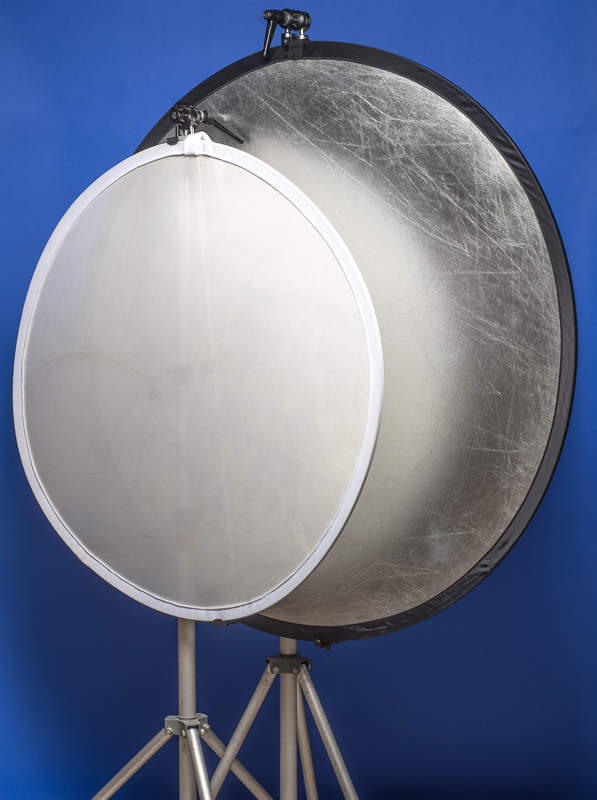
Circular diffuser (front) and reflector. Flat units with spring steel frame make packing and use simple. Often, mounting on a light stand with arm is helpful.
Diffusers are translucent fabrics that soften the light by scattering of the light that passes through the material and create the ability to make the light source larger and closer relative to the subject. Diffusers may be circular or rectangular and range in size from a few inches to 20 feet.
Umbrellas and soft boxes are essentially external modifiers that act like parabolic reflectors or enclosed reflectors with a diffuser material front.
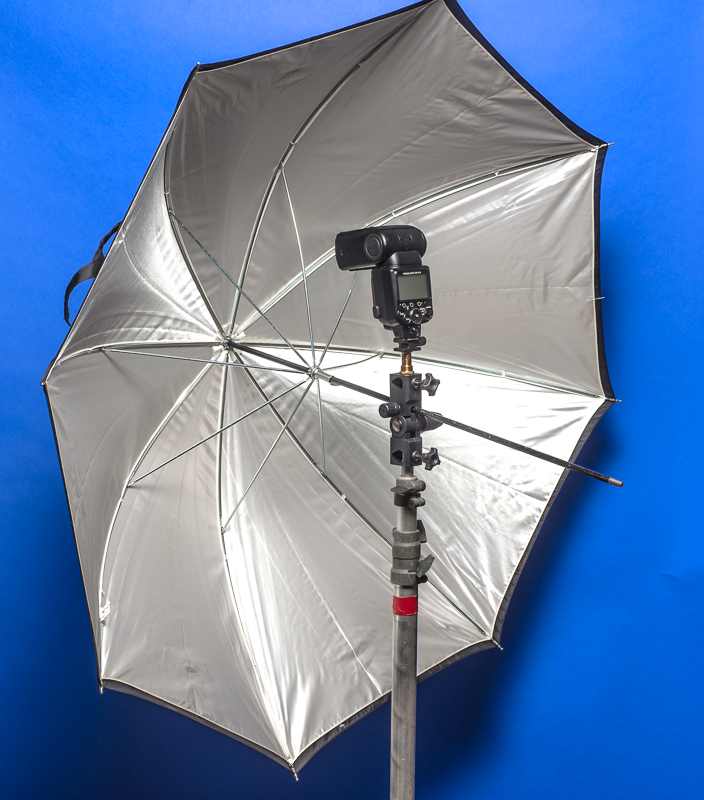
Silver reflective umbrella with Nikon SB-910 Speedlight electronic flash.
Umbrellas are perhaps the most simple of the two in that they mount with the lighting fixture pointing into the inside radius of the umbrella curve. When mounted on a light stand the light fixture and umbrella will make a much broader and softer light for the subject. Some umbrellas are soft white or some are silver and produce a more hard-edged, spectral light. Some are translucent and, when used in a “shoot-through” style, act as a circular diffuser. Some umbrellas now offer an opaque silver fabric with a diffusing panel for the open end, creating more of a soft box effect.
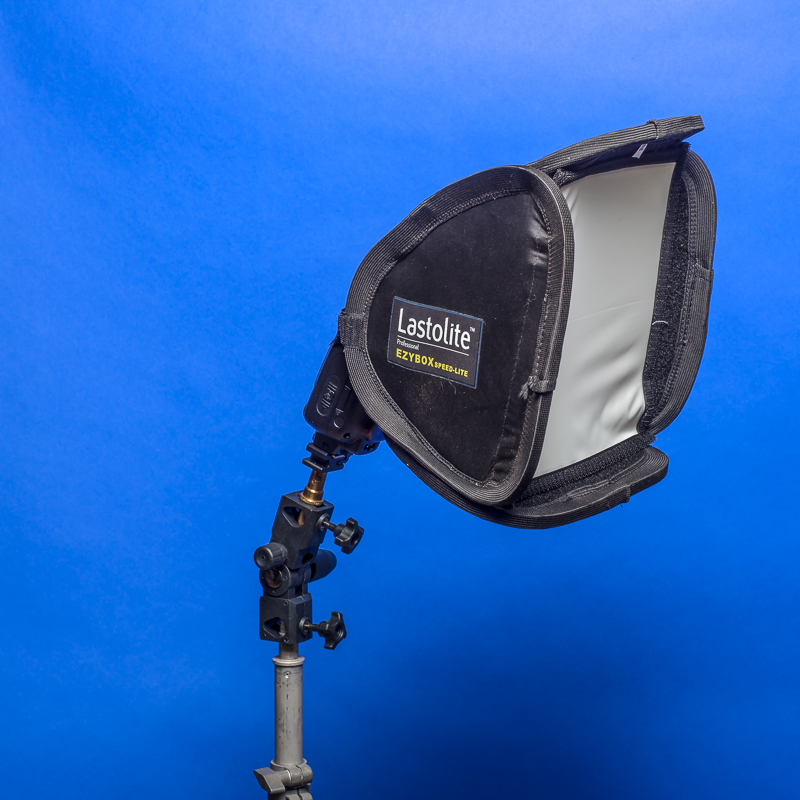
Lastolight EXBox soft box is designed for Speedlight miniature electronic flashes. Softbox units come from 8 inches (shown) to several feet in size.
Soft boxes are three-dimensional fabric modifiers constructed with an internal spring rib to enclose the lighting fixture. Often made from high temperature, or flame-proof fabric the light bounces around the highly reflective inside walls and through translucent diffusing baffles at the opening of the soft box. Soft boxes are available in rectangular or square shapes from a few inches across to several feet in size.
Grids are honeycomb-like screen modifiers that fit onto the front of a lighting fixture that directs the light into a very constricted pool. Grids come in a variety of gradations of modification from 100 to about 600 or more, each spreading the light to a different degree. Fabric grids are also made for the front of soft boxes to provide a more controlled direction for the soft, diffused light beam.
Snoots are like funnels that are attached to the front of the fixture that narrow the beam to a very small circle.
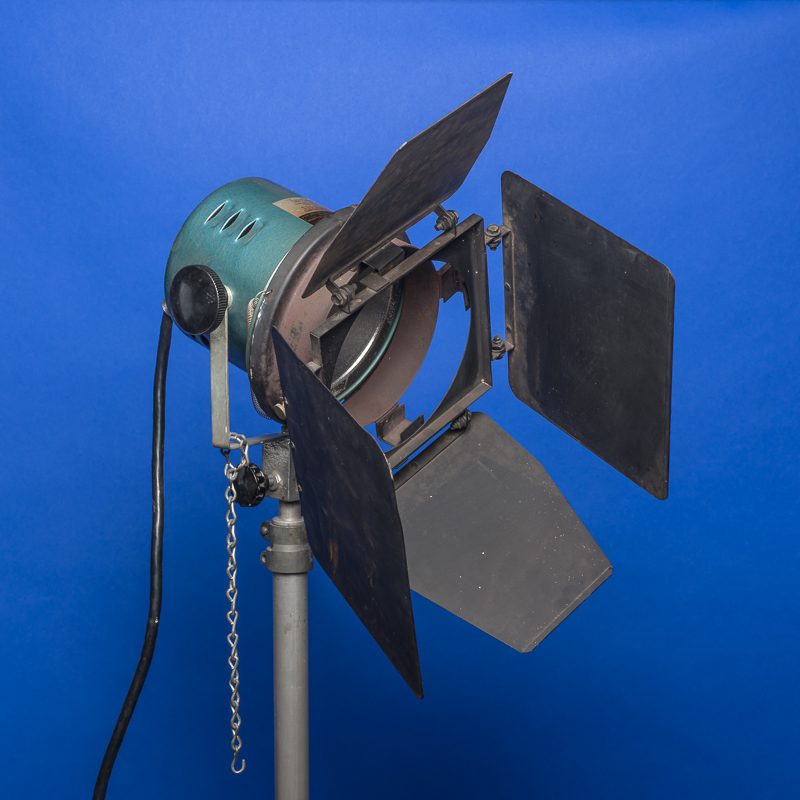
Barn doors on parabolic light fixture.
Barn doors are four, hinged parallel flaps that operate in four directions on the front of the fixture. In this manner the beam of light may be shaped and directed at will and may also be kept away from areas where unwanted.
Gel holders are often used in conjunction with barn doors to attach transparent colored gelatin filter “gels” in front of a lighting fixture. These gels may be used to correct the color temperature of the lamp or to provide a creative color effect.
Flags are opaque materials that block the light path. Originally rectangular fabric hanging on a pole, they looked like a flag, hence the name. Today, flags are lightweight materials like plywood or plastic or opaque fabric held within a framework and mounted on a secondary light stand. They are used anywhere to control the unwanted path or spill of light.
Gobos have a couple of meanings in the world of photographic lighting. The first and truly correct is that of a specially perforated disk, cut into numerous shapes that go before the optics in the fixture (gobo), creating a patterned light shape on the surface of the set. Most frequently, these are metal or glass disks that are inserted into the fixture itself. The resultant shape of light and shadow may resemble anything from clouds to trees or leaves, etc. A secondary, yet less accurate meaning is anything that is placed into the light path to block, cut or modify the resulting lighting form.
Cucoloris or “cookie,” is an opaque object that when placed into the light path will create a crafted shadow. Common examples can include a window frame with its panels that create the impression of window light on a wall because of the shadow. Frequently, cookies are cut from thin, and lightweight wooden panels into very nebulous shapes simply to create an abstract shape on the background. Cookies are most often positioned on a second light stand in front of the fixture so that the size and hardness of the shadow can be varied.
Grip Equipment
It is understandable that these many fixtures and modifiers require specialized support in use, regardless whether used indoors or outside. It can be effective to have an extra set of hands to hold, or grip, the modifier. As such, grip equipment includes the many different support and connection pieces from clamps, stands, booms, etc. that are used in the industry.
The many grip tools are too numerous to list here but the most important tools include light stands and arms for the mounting of light fixtures and light modifiers. Light stands are commonly a tall, vertical pole that is adjustable in height with tripod feet with a fixture mount on top. Light stands come in heights from a few inches tall to hide behind a portrait subject to light the background to many feet tall to hold the heaviest of lighting fixtures at 200 pounds or more. A lighting arm mounts to the light stand with a knuckle swivel device to hold and give control to various modifiers.
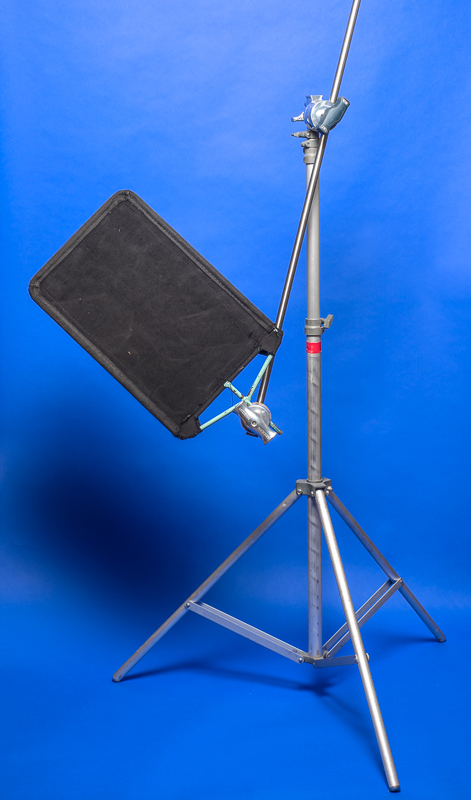
Traditional light stand with grip arm and flag.
As can be seen, the lighting arsenal for photographers is great. One doesn’t need to employ every type of fixture and modifier. Early on a photographer should plan the needs based upon foreseeable requirements and plan a system for the future. Some will prefer studio types of strobes, others may opt for Speedlights. Regardless, the early plan should keep in mind versatility, compatibility and room for future expansion.
Copyright © 2015 Brian Loflin. All rights reserved.


